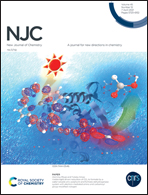Theoretical analysis of means of preventing Si–C bond cleavage during polycondensation of organosilanes to organosilicas†
Abstract
Organosilica materials can be synthesized via sol–gel polycondensation of organosilanes under acidic or basic conditions, although the cleavage of Si–C bonds in the arylsilane precursors is a major challenge. The present study investigated three practical strategies for suppressing Si–C bond cleavage of arylsilanes, using quantum chemical calculations. These were: (i) changing the position of the silyl group on the aromatic ring, (ii) inserting alkyl linkers into the Si–C bond, and (iii) removing metal ions from the organosilane ligands. Building on prior work, the stabilities of key intermediates in the Si–C cleavage reaction were numerically evaluated by calculating proton affinity (PA) values, and the effects of structural modifications of the arylsilanes were explored. With respect to strategy (i), the calculated PA values demonstrate that the stability of the Si–C bond is dependent on both the position of the silyl group and the reaction conditions. In the case of strategy (ii), the effects of incorporating (CH2)m linkers (m = 1–3) were examined. The results suggest that the insertion of (CH2)m with m ≥ 2 could potentially suppress Si–C cleavage under basic conditions. With respect to strategy (iii), the coordination of bipyridine organosilane precursors to metal ions was found to greatly affect PA values. The results suggest that metal ions in the reaction solution could possibly promote Si–C cleavage under basic conditions.



 Please wait while we load your content...
Please wait while we load your content...